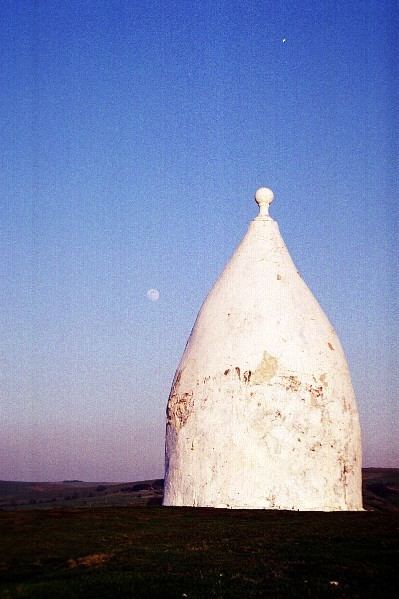OS grid reference SJ 939 771 Reference no. 1138973 Year built 1815 | Built for Gaskell family Elevation 280 m Designated as world heritage site 17 March 1966 | |
 | ||
Hours Open today · Open 24 hoursSundayOpen 24 hoursMondayOpen 24 hoursTuesdayOpen 24 hoursWednesdayOpen 24 hoursThursdayOpen 24 hoursFridayOpen 24 hoursSaturdayOpen 24 hoursSuggest an edit Similar Clarence Mill, Macclesfield Canal, Middlewood Way, Tegg's Nose Country P, Lamaload Reservoir | ||
The kerridge and white nancy out and about
White Nancy is a structure at the top of the northern extremity of the Saddle of Kerridge, predominantly in the Parish of Rainow, overlooking the village of Kerridge and the town of Bollington, Cheshire, England. Since 1966 it has been recorded in the National Heritage List for England as a designated Grade II listed building. Its profile forms the logo for the town of Bollington. As to the origin of the name White Nancy, there are several theories: it may have been named after one of the Gaskell daughters, Nancy, or maybe after the horse that is said to have hauled the table top up the hill.
Contents
- The kerridge and white nancy out and about
- White nancy
- History
- Description
- Painting
- Visitor attraction
- References
White nancy
History
White Nancy was built in 1817 by John Gaskell junior of North End Farm to commemorate the victory at the Battle of Waterloo. John Gaskell was a member of the Gaskell family who lived nearby at Ingersley Hall. It originally had an entrance to a single room which was furnished with stone benches and a central round stone table, but the entrance is now blocked. It has been described as a summer house or a folly.
In the mid-1940s, the Royal Signal Corps Trials Unit based at Catterick would drive a truck-mounted dish-shaped transmitter/receiver up to White Nancy. Here they tested cathode-ray tube transmission and reception (data-based, not images), to a mobile receiving station on another truck. The receiver would be driven further and further south over time, until eventually the lads at White Nancy were sending a signal to the south coast of the country. Locals told the signallers that the landmark was named after the lead horse that had transported all the materials for the building of White Nancy.
Description
The structure is circular in plan with its shape described as that of a sugar loaf, and is surmounted with a ball finial. It is built in sandstone rubble which has been rendered and painted. It is about 18 feet (5 m) high. Stone paving has been laid around its base which is inscribed with the points of the compass.
Painting
Until at least 1925 the structure was unpainted. It has been painted in a number of different colours over the years, most commonly in white. In 2005 vandals painted it partly in pink. In March 2009 it was repainted in white with the ball finial in black. In 2012 a Jubilee crown and the dates 1952–2012 were added to the north-west face and Olympic rings added to the south-east face. The green ring is in the form of a laurel wreath encircling a gold medal and the number 29 which was added later to mark Team GB's 29 gold medals. It was also been painted with a large red remembrance poppy whilst during the 1980s she was commonly painted at Christmas, decorated as a Christmas pudding or Father Christmas.
To commemorate White Nancy's possible reason for being built, the structure was painted with a '200th Anniversary of the Battle Of Waterloo' motif, and the silhouettes of soldiers in traditional garb from time. In May 2016 it was returned to its traditional all white with a black finial.
Visitor attraction
White Nancy provides a focus on the ridge of the Saddle of Kerridge and from it there are extensive views across the Cheshire Plain towards the mountains of North Wales to the west, the hills of Shropshire to the south and the Pennines to the north and east. White Nancy and the Kerridge ridge are part of the Gritstone Trail.
White Nancy has been acclaimed and has featured in countdowns of the best British follies identified by The Telegraph and by Alan Titchmarsh.
